This page will provide step-by-step instructions for conducting a Wide Area Search (WAS). These steps should be completed in the order presented. The settings recommended provide a starting point, but may need to be adjusted depending on the scenario and conditions.
There is an abbreviated summary of these steps in checklist form at the end of this document. The checklist can be printed for use in the field.
1 Mission Planning
Preparing for a Wide Area Search operation includes gathering information, defining the area to be covered and deciding on various settings to be used while conducting the search. The search area and the settings can easily be changed during the search, but it is a good idea to use the recommendations that follow as a starting point.
The steps included in this section are specific to this standard operating procedure and do not include other more general aspects of mission planning such as crew assignments and roles, logistics and supplies, transportation to and from the site, etc. See our Defender Resources for more information and recommendations.
![]() The steps in the Mission Planning phase can be completed either on-site or in a more comfortable environment.
The steps in the Mission Planning phase can be completed either on-site or in a more comfortable environment.
1.1 Obtain a Chart
Not all projects will require a chart. For example, a chart may not be needed for a search in open water remote from a shoreline unless the purpose is for mapping an area. In other situations, you may not have access to charts and may need to create a region in the field. In this case, a procedure for working without a chart will be provided in the Place a Region section. If a chart is not needed or available, the steps for obtaining and loading a chart can be skipped.
There are several programs and online services for obtaining charts for various locations around the world. Some are available for free and other sources charge fees. Alternatively, Google Earth and Sat2Chart can be used to create charts as needed at no cost. For more information about these options, see: Creating and Using Charts
![]() Sat2Chart is a Microsoft Windows based program and a Windows computer is required in order to use Sat2Chart.
Sat2Chart is a Microsoft Windows based program and a Windows computer is required in order to use Sat2Chart.
Once a chart is obtained, it will need to be copied to the operator control console. There is a charts folder in the home folder of the operator control console. When archiving the project, it is a good idea to copy any charts used for the project into the archive for that project.
![]() The resolution and quality of charts will vary depending on the source and amount of area covered. If the planned search covers a large area and you want to maximize the resolution of the chart, you can create several charts to cover the area at higher resolution instead of one chart covering the entire area.
The resolution and quality of charts will vary depending on the source and amount of area covered. If the planned search covers a large area and you want to maximize the resolution of the chart, you can create several charts to cover the area at higher resolution instead of one chart covering the entire area.
1.2 Load the Chart
After obtaining a chart and copying it to the operator control console, the chart can be loaded into EOD Workspace. There are two ways the chart can be loaded. Both methods require that EOD Workspace is running and the Map view is visible.
- Open a file manager window, browse to the folder with the chart and drag and drop the chart onto the EOD Workspace map area.
- Select the Map Config tab -> Charts subtab. Click on the Import Chart button. Browse to the file location and select the desired chart.
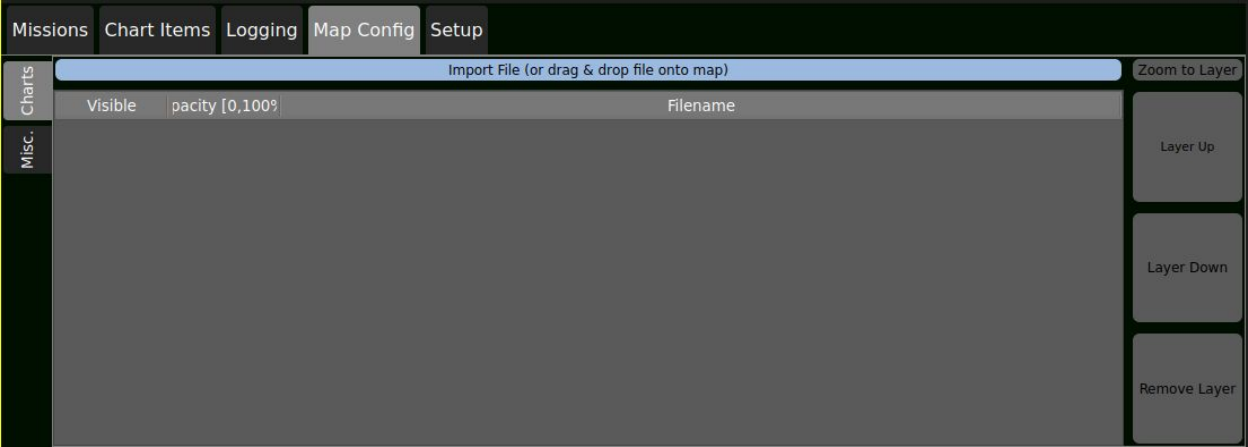
![]() After the chart is loaded, you can toggle the visibility (on | off), set the opacity (0 – 100%), and if multiple charts are loaded, change the layer order of the chart.
After the chart is loaded, you can toggle the visibility (on | off), set the opacity (0 – 100%), and if multiple charts are loaded, change the layer order of the chart.
1.3 Set Up the Video Overlay as Desired
The video overlay can be used to add valuable information to the permanent record about an operation. Consider adding notes about the project name, location, participants, and if the operation requires multiple dives, identifying each dive with a sequence number, etc.
To open the Video Overlay controls, click on the Stethoscope Diagnostics button and then select the Vehicle Configuration tab.

1.4 Set Up the Waypoint Defaults
In preparation for placing the waypoints that will define the search pattern for the ROV to follow, it is important to set up the defaults that will be applied to each waypoint.
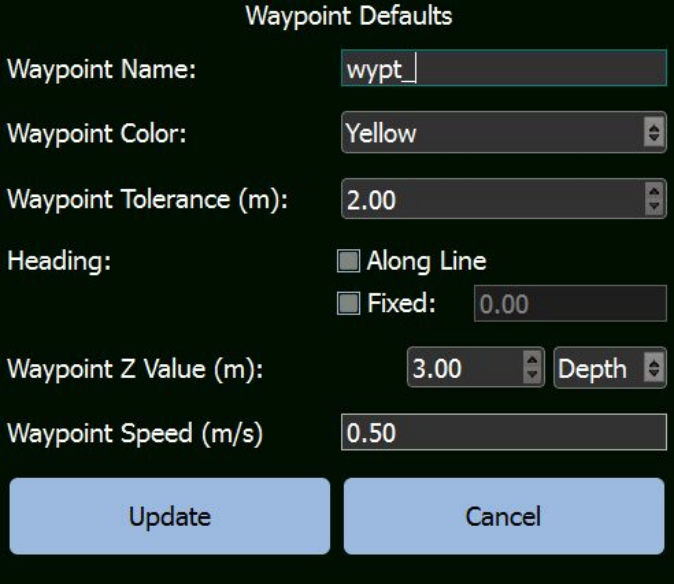
![]() Waypoints can be edited after they have been placed, either singly or in groups.
Waypoints can be edited after they have been placed, either singly or in groups.
Recommended Settings
| Parameter | Value |
|---|---|
| Waypoint Name | As desired |
| Waypoint Color | As desired |
| Waypoint Tolerance | 2 m (6 ft) |
| Heading | No items checked |
| Waypoint Z Value | Typically 1 – 3 m (5 – 10 ft, but not less then 1 , (3 ft)) |
| Depth/Altitude | Typically Altitude |
| Speed | 0.5 m/s (1.5 – 2 ft/s) |
![]() Altitude should not be less than 1 m (3 ft).
Altitude should not be less than 1 m (3 ft).
![]() Speed should be reduced at lower altitudes or in reduced visibility to avoid impacting the bottom or objects sticking up from the bottom.
Speed should be reduced at lower altitudes or in reduced visibility to avoid impacting the bottom or objects sticking up from the bottom.
1.5 Define the Parameters for the Search
Each mission will require an analysis of the requirements and determination of the appropriate settings to use during the search to achieve the objectives.
The following settings are recommended for a drowning victim search (assuming a 1.8 m (6 ft) person) and are based on the experiences accumulated during a number of successful recoveries. Searches for other size objects or area clearing or mapping may require different settings to optimize the chances for success in those situations.
- Sonar range: 18 m (60 ft) ~ 10 X object size
- Camera angle: ~ 5 – 10 degrees down
- Vehicle pitch: ~ 5 – 10 degrees nose down
- Define pattern perimeter: as determined by confidence in the information about point last seen and local geography and water conditions (still water of swift current)
- Define pattern orientation: Traversing longer pattern transects is generally better than shorter ones. Some consideration should be given to the launch point relative to the pattern, but the mission can be navigated through the pattern in either direction.
- Define transect spacing: 18 m (60 ft) ~ the sonar range, allowing approximately 25% overlap.
 This recommendation is based on using a wide angle sonar with a horizontal beam angle of 120 – 130 degrees. If using a high frequency sonar with a horizontal beam angle of 45 degrees, the recommended transect spacing should be reduced to about 35% of the sonar range to maintain adequate coverage.
This recommendation is based on using a wide angle sonar with a horizontal beam angle of 120 – 130 degrees. If using a high frequency sonar with a horizontal beam angle of 45 degrees, the recommended transect spacing should be reduced to about 35% of the sonar range to maintain adequate coverage.
These settings can be made during the steps that follow for setting the Waypoint Defaults, Placing a Region and Setting the Coverage.
The above guidelines are recommended starting points and can be modified as appropriate for the operation.
![]() The region size and shape is defined by the user.
The region size and shape is defined by the user.
| Project Type | Recommendation |
|---|---|
| Wide Area Search | The region should be centered on the best information available for the location of the object. The less certainty of the object’s location, the larger the search area may need to be. |
| Clearing or Mapping an Area | Defined by the perimeter of the area to be cleared or mapped. |
![]() For very large search areas, the area can be broken down into smaller overlapping regions.
For very large search areas, the area can be broken down into smaller overlapping regions.
1.6 Place a Region
![]() If you have not defined the perimeter of the desired region, review section 1.5 (Define the Search Parameters) for more information and recommendations.
If you have not defined the perimeter of the desired region, review section 1.5 (Define the Search Parameters) for more information and recommendations.
![]() Traversing a region is usually best done in the long dimension rather than the short one to minimize the number of turns required.
Traversing a region is usually best done in the long dimension rather than the short one to minimize the number of turns required.
The region should extend slightly beyond the extents of the search area in the direction of the transects. You want the search to be conducted while running the transects and not during the turns at the ends. By selecting an area slightly larger, you can ensure the turns are made outside of the desired area of coverage.
To place the region, make sure the Map view is visible and select the Missions tab -> Regions subtab. Click on the New Region button. Using the mouse, click on the map to draw the perimeter of the region.
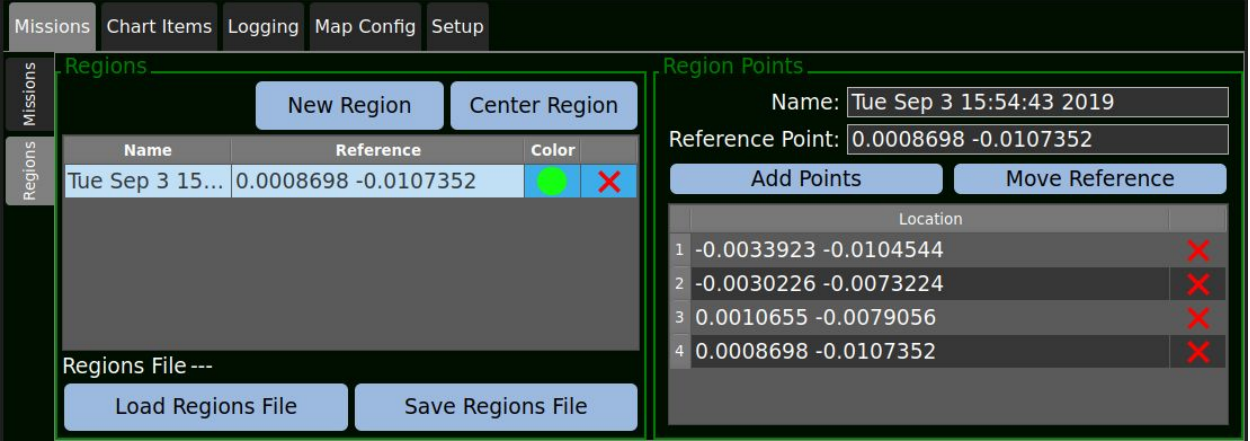
Generally, the region does not need to be 100% accurate as long as it extends slightly beyond the desired area of coverage as noted above.
You can expand the region by clicking new points outside of the existing perimeter.
You can delete region at any time and place new region if you are not satisfied with the result.
1.6.1 Set the Region Coverage
![]() If you have not determined the Transect spacing for region, review section 1.5 (Define the Search Parameters) for more information and recommendations.
If you have not determined the Transect spacing for region, review section 1.5 (Define the Search Parameters) for more information and recommendations.
To set the region coverage, right-click on the region and select Set Coverage.
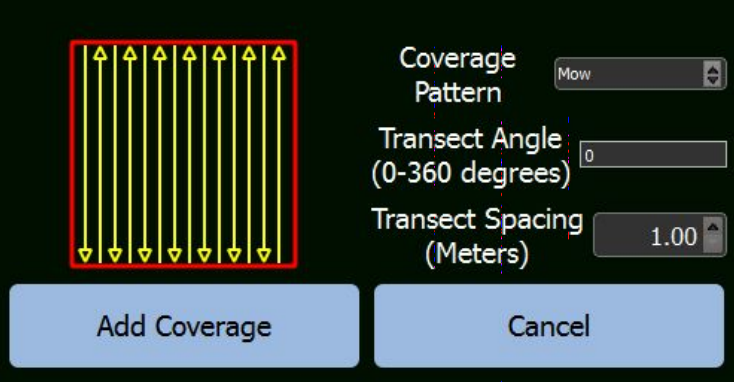
- The recommended Coverage Pattern is always “Mow.” The other patterns are not suitable for ROV work.
- The Transect Angle (pattern orientation) can be set to the desired angle.
 Traversing a region is usually best done in the long dimension rather than the short one to minimize the number of turns required.
Traversing a region is usually best done in the long dimension rather than the short one to minimize the number of turns required. - The Transect Spacing can be set as desired. The spacing should allow overlap and not exceed the visible or sonar range. Using the anticipated sonar range provides adequate overlap of about 25%. Sonar targets outside of the center 50% of the image in the corners as not visible for as long as targets that are centrally located within the image. Without sufficient overlap, targets in the corners may be easily missed.
- After making the desired selections, click on the Add Coverage button.
- If you are not satisfied with the coverage, you can right-click on the region and select Set Coverage again without having to delete the existing coverage. The original coverage will be deleted automatically and replaced with the new coverage.
1.7 Save the Mission Plan
Saving the mission will ensure all of the waypoints are saved and can be recovered at any time in the future, even if the system has been used for other operations in-between. This is especially true for operations that will be repeated, like clearing or mapping an area on a regular basis or for change detection.
To save the mission, make sure the Map view is visible and select the Missions tab -> Missions subtab. Click on the Save button.

2 On-site Operations
2.1 Site Selection and Set Up
The first priority for the site selection and set up should be safety. Ensure that the area and selected location for the operator control console, operator seating, power source, tether deployment path and launch site are risk and hazard free.
If possible, set up the operator control console so that the operator is not looking into the sun or has the sun at his or her back. The operator should also wear dark clothing to prevent bright reflections in the monitor. A hat with a brim can reduce glare and the operator control console sunshade can be used to enhance the image quality compared to operating in direct sunlight.
Logistics supplies like pop-up tents for shelter from the sun or rain and amenities like drinking water are good to have on hand.
Special considerations may be needed if operating from a vessel. These may include:
- Location of the operator control console and operator seating:
- Stability, especially as anticipated sea state increases
- Not interfering with boat operations
- Access to power
- Tether deployment path (Be careful when routing through doors or windows to prevent pinching.)
- Tether deployment:
- Clear path to launch point
- Safe from propeller or anchor line fouling
![]() Tether handling from a vessel requires dedicated attention to the task and coordination with the vessel operator at all times.
Tether handling from a vessel requires dedicated attention to the task and coordination with the vessel operator at all times.
2.1.1 Begin the Predive Checklist
Begin the Predive Checklist up through the Functions Test:
- Conduct a Visual Inspection
- Make the Connections
- Start the System
- Test the System’s Functions
2.1.2 Initialize the Recording
Before launching the vehicle, record a short video clip of the location and crew. This can be stored with the project and used like a movie clapper to provide quick reference information about the operation. You only need to record a few seconds or you can allow the recording to continue to run. If you want, you can create a movie clapper and use it as well. Experience has shown that most underwater video footage looks similar and when viewed later, it is hard to determine which operation it was from the video alone.
2.1.3 Launch the Vehicle and Complete the Predive Checklist
Compete the remainder of the predive checklist, launching and stabilizing the vehicle and initializing the navigation by setting the location and declination.
- Launch the Vehicle
- Check / Adjust the Ballast
- Stabilize the Vehicle Using the Autos
- Initialize the Navigation System
Place a Home Waypoint at the location of the vehicle for easier navigation back to the launch site at the end of the mission. Use the waypoint defaults first or edit the waypoint to set depth to 0 after placing it).
2.2 Open the Mission Controls
Open the mission / jog controls so that you are ready to control the vehicle during the mission. This will allow you to make adjustments to the operating parameters easily while maintaining your focus on monitoring the sonar or video and investigating targets.
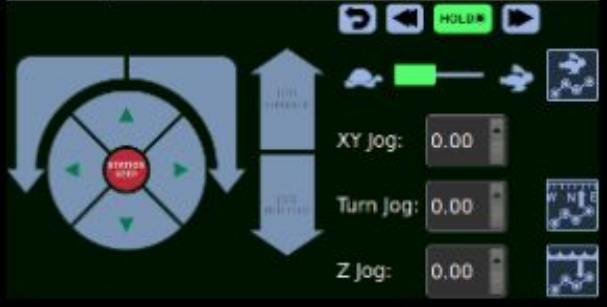
Set the Waypoint Locks as desired:
- Speed
- Heading
- Depth/Altitude
All three locks will normally be set to Locked (green).
2.3 Start the Recording
If you have not allowed the short initial video clip to continue recording, start the recording! This is critical, but with all of the activities going on, it is very easy to accidentally overlook this. There is a saying in the ROV world, “If you don’t have pictures, it didn’t happen.”
2.4 Conduct the Search, Area Clearing or Mapping Operation
After you have launched and stabilized the vehicle, there are several settings that you should double-check before immediately starting the mission. These steps ensure that you have enabled recording, the system is ready to go, and your settings are appropriate now that you are on-site and can assess the actual conditions.
The following items should be double-checked to ensure they are set or in the case of DVL Lock, that it is active.
- Recording is On
- Auto heading, altitude, pitch and roll should be On
- Dynamic Positioning should be On
- Waypoint locks should be set as desired
- DVL Lock is required
2.4.1 Start the Mission
To start the mission, Right-click on the desired waypoint and select Go to Waypoint. If the coverage you placed has the first waypoint on the far side of the region, you can first click on the Reverse button in the Mission / Jog Controls window so the mission will be navigated in the reverse order. In this case, right-click on the last waypoint and Select Go to Waypoint.
![]() You can start on any waypoint. The path will be through increasing waypoints or decreasing waypoints depending on the state of the Reverse button. You can also stop the mission at any time and restart at any waypoint.
You can start on any waypoint. The path will be through increasing waypoints or decreasing waypoints depending on the state of the Reverse button. You can also stop the mission at any time and restart at any waypoint.
2.4.2 Fine Tune the Settings as Appropriate
When the mission starts and before you begin your first transect, you should make sure the settings are appropriate for the conditions. Critical aspects to check include the sonar or visual range, the altitude, the pitch and camera angle. Make sure all of these are set satisfactorily to ensure good imagery and good overlap to maximize the ability to find targets. If they are not satisfactory, now is the time to make adjustments.
2.4.3 Monitor the Sensors
While running transects, your job should be monitoring the sonar and video looking for targets of interest with a side job of ensuring the vehicle remains on course and does not run into an unforeseen obstruction. In general, the vehicle will navigate itself from waypoint to waypoint so you can focus as much as possible on reviewing the data being provided by the sensors.
![]() You can edit the mission dynamically if you need to make adjustments.
You can edit the mission dynamically if you need to make adjustments.
2.4.4 Evaluate Sensor Data for the Objectives
If you see something of interest or need to take a closer look at a target during the mission, you have various controls at your disposal. Use these controls to observe targets of interest in more detail, up close or for longer periods of time.
| Desired Result | Action Required |
|---|---|
| To stop the vehicle and hold position… | Displace the joystick. |
| To turn the heading while maintaining course on the transect… | Rotate the joystick to change the heading. |
| To change the speed… | Use the Turtle / Rabbit slider. |
| To change the altitude… | Use the depth control knob. |
![]() If you exercise any of the last three actions, this will disable the waypoint lock for that action. If you want to return to locked operations after you complete your investigation of a target, you will need to reactivate the lock by clicking on it.
If you exercise any of the last three actions, this will disable the waypoint lock for that action. If you want to return to locked operations after you complete your investigation of a target, you will need to reactivate the lock by clicking on it.
Do not be afraid to take a lot of snapshots. They can be valuable for post process analysis and they can create a time-stamped index to the video footage if you have the date and time visible on the video overlay.
If you need to make a closer inspection of an object, you can displace the joystick to stop the mission and then use the Orbit feature.
You can use the Hold button to pause the mission when the ROV reaches the next waypoint. This can be helpful if you need to do something non-mission related, i.e. consult with a colleague, take a break, etc.
Looking for targets for long periods of time can be boring and you can lose your mental acuity for the task. It is a good idea to take breaks or rotate assignments to maintain optimal focus.
2.4.4.1 Looking for an Object
If a suspected target is found, you should set an MOB point (ROV position, heading, attitude and depth) and mark the target with a Marker and take a snapshot. This will provide some redundancy and if you lose sight or sonar image of the target, you can navigate back to the point where you know you were able to observe it before.
“A bird in the hand is worth two in the bush.” It is usually best to inspect and identify possible targets when they are first observed rather than to mark numerous targets and wait until the end of the mission to go back to review them. You can easily restart the mission where you left off or by right-clicking on any waypoint and selecting Go to Waypoint or by clicking on the Skip button.
![]() If you don’t find the object, but have high confidence you are in the correct vicinity, try to navigate the area again using a different coverage angle. The object may present a better orientation to be picked up visually or on sonar, or it may be obscured by the terrain when viewed from certain directions.
If you don’t find the object, but have high confidence you are in the correct vicinity, try to navigate the area again using a different coverage angle. The object may present a better orientation to be picked up visually or on sonar, or it may be obscured by the terrain when viewed from certain directions.
2.4.4.2 Clearing an Area
If you are clearing an area based on a side scan image the goal will be to find the possible targets of concern that might have been located using the side scan. The ROV can then be sent to investigate those targets closer and identify them. In this case, the coordinates can be entered and the ROV sent to each targets location directly rather than navigating a pattern through a region. In general all targets will be able to be inspected using this technique. If you are unable to locate a target, or you are clearing an area using only the ROV, you will need to apply a region and this Wide Area Search SOP.
If a suspected target is found, you should set an MOB point (ROV position, heading, attitude and depth) and mark the target with a Marker and take a snapshot. This will provide some redundancy and if you lose sight or sonar image of the target, you can navigate back to the point where you know you were able to observe it before.
“A bird in the hand is worth two in the bush.” It is usually best to inspect and identify possible targets when they are first observed rather than to mark numerous targets and wait until the end of the mission to go back to review them. You can easily restart the mission where you left off or by right-clicking on any waypoint and selecting Go to Waypoint or by clicking on the Skip button.
If you plan to clear the area on a periodic basis, you can save the mission, which will save the Markers and MOB points in addition to the waypoints. Then, when clearing the area again in the future, you can look for exceptions knowing what was there already and does not need to be investigated in detail.
Obviously, how to deal with unknown objects that are found is up to the user and beyond the scope of this manual.
2.4.4.3 Mapping an Area
There are many purposes for mapping an area. In general, the purpose is to develop a point plot of objects of interest or define regions and their associated perimeters for some type of habitat or physical characteristics within the area. Markers can be used to define both. Snapshots that include video and sonar data should be taken frequently. These can be geolocated based on the coordinates on the map view or in the video overlay, which can be included in the snapshot.
Additional data such as temperature / location can be extracted using the CSV Export feature. This information can be used to map thermoclines or create contour maps.
3 Vehicle Recovery
At the conclusion of the Wide Area Search (WAS) operation, the vehicle should be piloted to the launch site and recovered. Following the standard Post Dive Operations is recommended.
3.1 Return to the Launch Site
At the conclusion of the operation, the ROV should be navigated to the launch site.
![]() If a Home Waypoint was placed, the ROV can be brought to the surface and then commanded to go to the Home Waypoint. Be aware that if the ROV was submerged for a long period of time, the naturally accumulated navigation error of the DVL may mean there is an error in the ROV’s position. If the ROV is brought to the surface, the ROV GPS can be used to remove the error and ensure that the ROV will arrive at the expected location of the Home Waypoint.
If a Home Waypoint was placed, the ROV can be brought to the surface and then commanded to go to the Home Waypoint. Be aware that if the ROV was submerged for a long period of time, the naturally accumulated navigation error of the DVL may mean there is an error in the ROV’s position. If the ROV is brought to the surface, the ROV GPS can be used to remove the error and ensure that the ROV will arrive at the expected location of the Home Waypoint.
If a Home Waypoint was not placed, you can add a Waypoint at the launch location or navigate the ROV home manually.
![]() It is usually best to navigate the vehicle back to the launch point on the surface to avoid hitting an obstacle or getting the tether snagged on something.
It is usually best to navigate the vehicle back to the launch point on the surface to avoid hitting an obstacle or getting the tether snagged on something.
3.2 Stop the Recording
The recording should be stopped before shutting down the operator control console to ensure the recorded files are closed properly on the disk. If the program is stopped while recording is in progress, the files can become corrupt and unusable.
3.3 Save the Mission
After the mission is completed the mission should be saved. This will ensure that all of the added Waypoints, Markers, MOB points and other data entered will be stored as part of the data set for the project.
3.4 Recover the Vehicle
Recover the vehicle and complete the standard post dive procedures.
- Turn off all Autos and Dynamic Positioning
- Retrieve the Vehicle
- Make sure the recording has been stopped
- Stop EOD Workspace
- Turn off the ROV power
- Turn off the Operator Control Console
- Disconnect all connections
- Stow the equipment for transport
Make sure to clean the vehicle on site or as soon as possible after you have returned to your home base.
4 Post Mission
Activities for post mission operations may vary depending on the requirements. Collected data may need to be analyzed and archived.
4.1 Analyze the Data
In searches where an object is found, data analysis may not be required. In other situations, it may be necessary to review the data to prepare for the next day’s operation, or for area clearing and mapping applications. Analysis may include measuring and identifying sonar targets, georeferencing target locations or reviewing video data.
Example of Using Post Mission Data Analysis Successfully
While exploring a shipwreck at 300 m (1,000 ft), an ROV became entangled on the wreck. A recovery dive was attempted using another ROV, but the trapped ROV could not be located. The sonar from the original dive was then carefully reviewed and a hand drawn mosaic map was created from the sonar imagery including the location of the trapped ROV on the wreck.
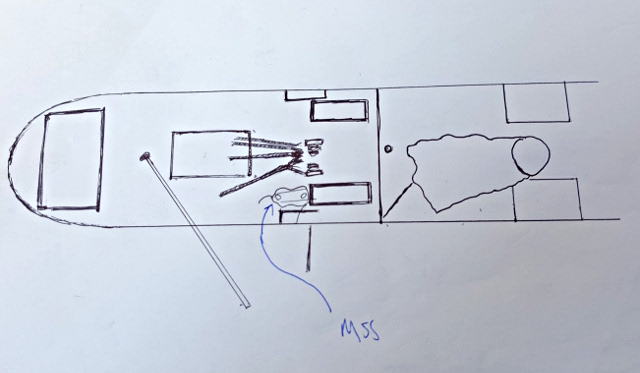
Using this ad hoc map of the ship, the second recovery dive was successful at finding and retrieving the trapped ROV. The success was attributed to the ability to use the reference map to identify the location of the recovery ROV relative to the wreck and then navigating to find the trapped ROV.
4.2 Archive the Data
Data collected during the operation should be removed from the Operator Control Console on a regular basis (preferably after each mission) by using a network connection or flash drive and the files should be stored in a project folder on a server or copied to a permanent storage media for archival purposes.
The files to archive include:
- Charts (/Home/charts/)
- The saved Mission (/Home/waypoint_data.yml)
- The recorded files in the logging folder (/Home/gss_bin), including (video.mp4, sonar.mp4 and telemetry) – these files are named by data and time by default.
- If screen shots were taken using the PrtScn key, these can be found in the /Home/Pictures folder.
